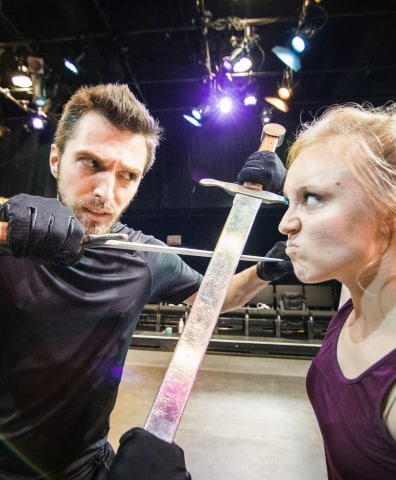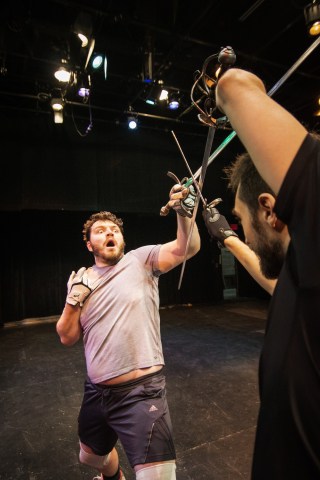 In August 2018, the annual National Fight Directors Conference was held in the drama department at the University of Saskatchewan — it was a long month for students interested in receiving any level of Stage Combat Certification.
In August 2018, the annual National Fight Directors Conference was held in the drama department at the University of Saskatchewan — it was a long month for students interested in receiving any level of Stage Combat Certification.
The NFDC is a program essential to understanding and applying the intricacies of safe stage combat to minimize any risk of injury to actors during performance. Iain Rose, a certified fight instructor and the technical director of the U of S drama department, says the course is a dynamic one.
“We had 18 basic actor-combatant students, and we had six that were going for their intermediate level. We developed choreography for them over the first two weeks of the course, taught it to them, and then, the final week is where they pull that choreography into some kind of dramatic scene,” Rose said.
“We have some members who come from strictly martial arts backgrounds… our main focus is on teaching actors how to perform this activity safely in front of live audiences — that’s the origin of Fight Directors Canada, when it was established in 1992,” Rose said.
Stage combat has not always been this structured. In the past, Rose says that “[producers] would often would hire the local fencing coach, or hire a boxer, or someone with some sort of fight training.”
It’s necessary for stage fighting to appear realistic, but by its nature, stage fighting is much more choreographed than traditional martial arts.
“We telegraph big what we’re going to do before we’re gonna do it, so that your acting partner knows — and of course, this is coupled with hours and hours and hours of rehearsal to be able to do it safely, especially when you’re coming at each other, or thrusting at each other with blades,” Rose said.
According to Rose, stage combat is very specific and techniques vary between disciplines.
“It is all very technical — you have to have consistent eye contact so that you can read what the other person is doing visually. You have to have consistent and practised footwork so that your distance is consistent all the time,” Rose said. “If you’re doing a martial arts fight, that’s going to be different than a barroom brawl.”
There are a multitude of styles and backgrounds in stage combat, which also influence weapon props. “Because we like to put on the plays of the Bard — Macbeth, for example — you’re going to be dealing with medieval longsword or broadsword. If you’re going to be doing Romeo and Juliet, it’s Italian rapier and dagger,” Rose said. “It depends on the specific piece that you’re putting on.”
Aside from acting out armed combat scenarios, participants also learn how to sell fistfights as well.
“There’s an unarmed component at the basic level: A hit, or punch and kick, or throw. And how to fall without hurting yourself or your partner. A bit of wrestling on the ground — with the idea in mind that you can’t get hurt. If you’re going to be performing Hamlet, then you can’t have a black eye the next day, right?” Rose said.
In terms of what makes an effective fight, Rose says, “If the fight is seamless with the rest of the play and doesn’t seem unusual in a negative sense, then I’m really happy.”
Rose has a long history in both theatre and film, wearing many different hats. He’s worked as a construction coordinator, scenic carpenter, art director, special-effects coordinator and stunt actor. Included in his long list of work experience is six years working on the Saskatchewan-based comedy television series Corner Gas.
Rose suggests that there’s no better place to host the NFDC than the U of S.
“This is the oldest standalone drama department in the British Commonwealth — not many people are aware of that. That in itself is an incredible milestone for theatre in Canada,” Rose said. “We are all artists to some degree. I’m just fortunate enough to have pursued this as a career. Hopefully, everyone has a creative component to what they’re doing for a living because it makes it a lot easier to go to work in the morning.”
—
Riley Deacon / Photo Editor
Photo: Riley Deacon / Photo Editor